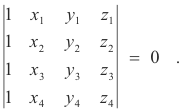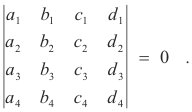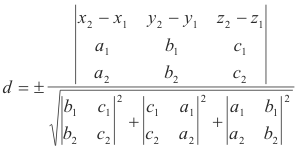Website owner: James Miller
Equations of a plane: general, normal, intercept and three-point forms. Equations of a line: parametric, symmetric and two-point form. Traces, intercepts, pencils.
Trace. If a line, plane or any surface in space intersects a coordinate plane, the point, line, or curve of intersection is called the trace of the line, plane or surface on that coordinate plane.
Intercept. The intercept of a straight line, curve, or surface on a coordinate axis is the distance from the origin to the point where the line, curve, or surface cuts the axis. The intercept on the x-axis is the x -intercept, the intercept on the y-axis is the y-intercept, and the intercept on the z-axis is the z-intercept.
Example. The intercepts of the line 2x + 3y = 6 on the x-axis and y-axis, respectively, are 3 and 2.
***************
PLANES
***************
Equation of a plane. In an x-y-z Cartesian coordinate system the general form of the equation of a plane is
ax + by + cz + d = 0 .
It is an equation of the first degree in three variables.
The locus of any equation of the first degree in three variables is a plane in three-dimensional Cartesian space. Conversely, any plane in space can be represented by some equation of the first degree in three variables. If one of the variables is missing (that is, if one of the coefficients a, b, c is zero), the plane is parallel to the axis of the missing variable. If two of the variables are missing, the plane is parallel to the plane of the missing variables.
Example. The equation z = k represents a plane parallel to the xy plane and k units from it.
Special forms of the equation of a plane:
1) Intercept form of the equation of a plane. The intercept form of the equation of a plane is
![]()
where a, b, and c are the x, y, and z intercepts, respectively (all intercepts assumed to be non-zero).
2) Three point form of the equation of a plane. The equation of a plane passing through three non-collinear points (x1, y1, z1), (x2, y2, z2), (x3, y3, z3) is

Evaluation by minors using the top row shows that it is of the first degree and thus represents a plane. It can also be seen that it is satisfied by the coordinates of each of the given points because if the coordinates of any one of the points is substituted in place of x, y and z, the determinant will contain two rows that are just alike, and so will vanish.
3) Normal or perpendicular form of the equation of a plane. A plane is determined if the length and the direction of the perpendicular line from the origin to the plane are known. The normal form of the equation of a plane is

1) λx + μy + νz - p = 0
where λ, μ, and ν represent the direction cosines of a normal to the plane directed away from the origin and p is the perpendicular distance from the origin to the plane.
This equation is best understood in its vector version. Let OQ be a line extending from the origin and perpendicular to plane C, intersecting plane C at Q, and of length p. See Fig. 1. Let n be a unit vector emanating from the origin and extending along line OQ. Let r be a position vector of a variable point P on plane C. Then
r • n = p
In words, this states the condition that the dot product of r times n is p which means that the projection of the vector r on the unit normal n is p. Here n = (λ, μ, ν) and r = (x, y, z). Thus r • n = p is equivalent to λx + μy + νz = p and we have an interpretation for 1) above.
4) Normal and one point form of the equation of a plane. If a plane passes through point (x0, y0, z0) and has a normal with direction numbers a, b, c its equation is
2) a(x - x0) + b(y - y0) + c(z - z0) = 0
This equation is also best understood in its vector version. Let P0 represent the point (x0, y0, z0), P represent the point (x, y, z), and n represent the vector (a, b, c). Now define vector S as
S = P - P0 = (x-x0, y-y0, z-z0)
Then
S • n = 0 .
In words, this states that the dot product of S and n is zero, which is the condition for perpendicularity of two vectors. Two vectors are perpendicular if and only if their dot product is zero. Since S • n = 0 is simply the vector form of a(x - x0) + b(y - y0) + c(z - z0) = 0 it gives an interpretation to 2).
Normal form of a plane in terms of the direction numbers of the normal. Let a plane lie at a perpendicular distance p from the origin. Let l, m, n be any set of direction numbers of the normal to the plane. Then



and the normal form of the equation of a plane becomes

where the sign of the radical can be determined only if we know on which side of the origin the plane passes.
Converting an equation in general form to normal form. Any equation of the general form
ax + by + cz + d = 0
can be expressed in the normal form by dividing it by
![]()
where the sign of the radical must be taken opposite to the sign of d so that the value of p will be positive. Thus ax + by + cz + d = 0 becomes

which is the equation of a plane whose normal has direction numbers a, b, c and whose distance from the origin is

Direction numbers for the normal to a plane. A set of direction numbers for the normal to the plane
ax + by + cz + d = 0
are the coefficients a, b, c.
Theorem. The coefficients a, b, c in the equation
ax + by + cz + d = 0
are direction numbers of the normal to the plane ax + by + cz + d = 0 . Conversely, any set of direction numbers of the normal to a plane can be used as the coefficients of x, y, and z in writing the equation of the plane.
Perpendicular distance of a point from a plane. Let D denotes the distance
from the plane ax + by + cz + d = 0, where d
![]() 0, to the point P1(x1, y1, z1). If this distance is
counted positive when P1 lies on the opposite side of the plane from the origin and negative when
it lies on the same side of the plane as the origin, then
0, to the point P1(x1, y1, z1). If this distance is
counted positive when P1 lies on the opposite side of the plane from the origin and negative when
it lies on the same side of the plane as the origin, then

where the sign of the radical is opposite to that of d.
Angle between two planes. The dihedral angle between two planes is measured by the angle between normals to the planes. The acute angle between planes a1x + b1y + c1z + d1 = 0 and a2x + b2y + c2z + d2 = 0 is given by

The two planes are perpendicular if and only if
a1a2 + b1b2 + c1c2 = 0 .
The two planes are parallel if and only if

Direction of line of intersection of two planes. A set of direction numbers for the line of intersection of the planes a1x + b1y + c1z + d1 = 0 and a2x + b2y + c2z + d2 = 0 is

Equation of plane through point P1(x1, y1, z1) and parallel to directions (a1, b1, c1) and (a2, b2, c2). A plane through point P1(x1, y1, z1) and parallel to directions (a1, b1, c1) and (a2, b2, c2) is given by

Equation of plane through point P1(x1, y1, z1) and P2(x2, y2, z2) and parallel to direction (a, b, c). A plane through point P1(x1, y1, z1) and P2(x2, y2, z2) and parallel to direction (a, b, c) is given by

Def. Pencil of planes. All the planes passing through a given line. The line is the axis of the pencil.
Theorem 1. Let II1 = 0 and II2 = 0 be the equations of two intersecting planes where II1 and II2 are linear expressions in x, y, and z. Then the family of planes
k1II1 + k2II2 = 0 ,
where k1 and k2 are parameters (arbitrary constants), is the pencil of planes passing through the intersection of the planes II1 = 0 and II2 = 0 .
Theorem 2. Four points (x1, y1, z1), (x2, y2, z2), (x3, y3, z3), and (x4, y4, z4) lie in the same plane if

Theorem 3. Four planes
a1x + b1y + c1z + d1 = 0
a2x + b2y + c2z + d2 = 0
a3x + b3y + c3z + d3 = 0
a4x + b4y + c4z + d4 = 0
pass through the same point if

***************
LINES
***************
Equations of a line. A line is determined in three principal ways:
1) By the intersection of two planes
2) By two points on the line
3) By a point and a set of direction numbers
Two-point form of equations of a line. If a line passes through the points P1(x1, y1, z1) and P2(x2, y2, z2) the equations for the line can be written as

Symmetric form of the equations for a line. If a line passes through the point P1(x1, y1, z1) with direction numbers l, m, n the equations for the line can be written as
![]()
Parametric form of the equations of a line. If a line passes through the point P1(x1, y1, z1) with direction numbers l, m, n the equations for the line can be written in parametric form as
x = x1 + lt
y = y1 + mt
z = z1 + nt .
As the parameter t varies through all real numbers these equations give the coordinates of all the points and only the points that lie on the line. Positive values of t correspond to points on one side of P1(x1, y1, z1), negative values of t to points on the other side, and the value zero to the point P1.
If a line passes through the point P1(x1, y1, z1) with direction cosines λ, μ, and ν the equations for the line can be written as
x = x1 + λt
y = y1 + μt
z = z1 + νt .
In this case the parameter t has special significance. It is the actual directed distance from P1 to P(x,y,z) along the line. To see this consider the vector form of the system where U corresponds to the unit vector U = ( λ, μ, ν ), X = (x, y, z) and X1 = (x1, y1, z1). The vector form then is
X = X1 + Ut .
If a line passes through two points P1(x1, y1, z1) and P2(x2, y2, z2) the equations of the line can be written
x = x1 + (x2 - x1)t
y = y1 + (y2 - y1)t
z = z1 + (z2 - z1)t
The point P1 corresponds to t = 0 and P2 to t = 1.
Distance between a point and a line. Let P0(x0, y0, z0) be any point and let L be a line passing through a point P1(x1, y1, z1) in direction (a, b, c). Let d be the perpendicular distance between P0 and line L. Then the distance d is given by

Distance between two skew lines. Let L1 be a line passing through point P1(x1, y1, z1) in direction (a1, b1, c1) and L2 be a line passing through point P2(x2, y2, z2) in direction (a2, b2, c2). Then the perpendicular distance d between the two lines is given by

References.
Samuel Selby. CRC Standard Mathematical Tables
Jesus Christ and His Teachings
Way of enlightenment, wisdom, and understanding
America, a corrupt, depraved, shameless country
On integrity and the lack of it
The test of a person's Christianity is what he is
Ninety five percent of the problems that most people have come from personal foolishness
Liberalism, socialism and the modern welfare state
The desire to harm, a motivation for conduct
On Self-sufficient Country Living, Homesteading
Topically Arranged Proverbs, Precepts, Quotations. Common Sayings. Poor Richard's Almanac.
Theory on the Formation of Character
People are like radio tuners --- they pick out and listen to one wavelength and ignore the rest
Cause of Character Traits --- According to Aristotle
We are what we eat --- living under the discipline of a diet
Avoiding problems and trouble in life
Role of habit in formation of character
Personal attributes of the true Christian
What determines a person's character?
Love of God and love of virtue are closely united
Intellectual disparities among people and the power in good habits
Tools of Satan. Tactics and Tricks used by the Devil.
The Natural Way -- The Unnatural Way
Wisdom, Reason and Virtue are closely related
Knowledge is one thing, wisdom is another
My views on Christianity in America
The most important thing in life is understanding
We are all examples --- for good or for bad
Television --- spiritual poison
The Prime Mover that decides "What We Are"
Where do our outlooks, attitudes and values come from?
Sin is serious business. The punishment for it is real. Hell is real.
Self-imposed discipline and regimentation
Achieving happiness in life --- a matter of the right strategies
Self-control, self-restraint, self-discipline basic to so much in life